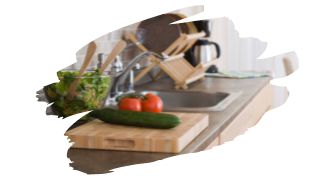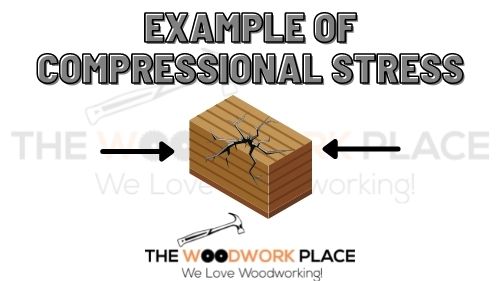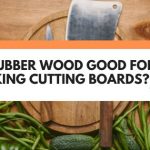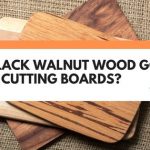Sapele wood makes for a great alternative to Genuine Mahogany. That’s because not only is Sapele wood much harder and tougher than Mahogany, it is more affordable too.
With Sapele you can have beautiful Mahogany style grain for your cutting board, without breaking the bank — or can you?
You see, there’s more to choosing the right cutting board wood than just it’s appearance. And when it comes to food safety in particular, not all wooden surfaces are created equal.
So, in this post, you will discover what you need to look for from cutting board material. You’ll also discover why certain types of wood grain texture can make for a less than food-safe surface.
And keep reading to learn if Sapele wood is the right choice for your next cutting board…

This post may contain affiliate links to products that we receive a commission for (at no additional cost to you). Learn more here.
What Is The Best Type Of Material For A Cutting Board?
Cutting board material needs to meet three key criteria;
A). It must be easy to keep sanitary and clean.
B). It must be hard enough to be able to absorb the impact of a chopping knife.
C). But, it mustn’t be so hard that it ends up damaging your cookware.
Based on this, the top four best materials for a chopping block are wood, bamboo, plastic, and rubber.
Related Post: Can You Put Food Safe Epoxy Resin On Cutting Boards?
OK…But What Is The Best Kind Of Wood For A Cutting Board?
This is where things get a little bit interesting. Not all types of wood are equally suited for becoming a food prepping surface.
You see, wood types that have large open pores, (such as Red Oak), are fairly tricky to keep clean of food bits.
That’s because little morsels of food can get caught up in the pores of these types of wood. And once that happens, this can make it all too easy for harmful bacteria to grow on your cutting board.
Worse still, they could increase the risk of raw food cross-contamination.
Now, another thing you need to check for, when selecting cutting board lumber, is the wood’s toughness. A cutting board needs to be hard enough to take on chops, but not so tough that it wrecks your kitchen cookware.
Related Post: What Food Grade Wood Glue Is Safe Enough For Your Cutting Board?
And How Do You Work Out How Tough Wood Is?
One of the things we look for in cutting board wood, is where it lies along the Janka Hardness Scale. And we can do this by checking woods Janka rating.
The Janka rating measures the compressional strength of a piece of wood. The higher the Janka rating, the greater that wood’s strength. And the stronger the wood, the harder and more impact-resistant it is.
For example, one of the most popular types of cutting board wood is Hard Maple (also known as Sugar Maple). This popular North American hardwood has a Janka rating of 1450 lbf. So, that means it takes some 1450 pounds of force to make a dent in this timber.
What Is Compressional Strength? Compressional strength refers to how well a piece of wood can hold up against compressional stresses put upon it.

Right… So What About Sapele Wood?
Sapele wood is surprisingly tough for a wood that often gets mistaken for Mahogany.
Sapele wood has a Janka rating of 1410 lbf, making it just a touch softer than Hard Maple. This also makes it much tougher than the Mahogany wood that you may be more familiar with.
Mahogany, (also known as Genuine Mahogany), is sourced from tropical rainforest’s in South America. And this deep brown timber has a Janka rating of around 900 lbf.
That’s A Good Thing, Right? Sapele Wood Should Be Plenty Tough Enough To Become A Cutting Board…
Yes it is, but, this wood isn’t suited for becoming an actively used food prepping surface. Let me explain.
Sapele Is Just About Tough Enough For The Chopping Block…
Sapele wood is clearly strong enough to absorb chopping blows. But it isn’t too hard for your cookware to handle.
You see, optimal cutting board wood should fall within a certain Janka hardness range.
If that timber has a Janka rating of less than 900 lbf, it won’t last too long in the kitchen. But, if it has a Janka rating of more than 1500 lbf, then your chopping utensils won’t last too long either.
But, wood types that fall within this limited Janka rating range, make for optimal chopping block material.
…But Sapele Wood Has Large Open Pores
Sapele is a diffuse porous wood with large open pores. Diffuse porous trees have roughly equally sized wood pores. And those pores are evenly dispersed, (i.e. diffused), across it’s growth rings.
Now, as a general rule of thumb, your typical North America diffuse-porous timber, (such as Red Maple), has small to medium sized pores.
But, diffuse porous hardwoods that grow in tropical areas, such as Mahogany wood, instead have fairly large sized pores. And Sapele wood — which is sourced from forests across West Africa — is no exception.
So, similarly to Red Oak, Sapele woods surface can make it all too easy for raw meat to get snagged in it. This can then create a cross-contamination risk, if you use Sapele wood as a food prep surface.
So If Sapele Wood Is Out, What Wood Is Best For Cutting Boards?
First off, if you simply want to make a decorative cutting board, Sapele wood is more than suitable. But, if you want to make a food prepping cutting board, you’re better off using wood such as Hard Maple.
Related Post: Acacia Vs Maple Cutting Boards (4 Key Pros And Cons)
To Wrap Up, Here Are The 3 Key Takeaways From This Post…
- 1). Cutting boards need to be made from woods that do not have large open pores. Cutting boards made from woods that have large open pores, can increase the risk of raw food cross-contamination.
- 2). Sapele wood has large open pores.
- 3). If you want to make a cutting board, then you’re better off using more suitable wood, such as Hard Maple.



